This article includes a list of general references, but it lacks sufficient corresponding inline citations .(January 2018) |



Ignacio de Ries (c. 1612 - after 1661) was a Spanish Baroque painter.
This article includes a list of general references, but it lacks sufficient corresponding inline citations .(January 2018) |



Ignacio de Ries (c. 1612 - after 1661) was a Spanish Baroque painter.
He was probably born in Flanders, then part of the Spanish Netherlands. Written sources show him active in Seville between 1636 and 1661. From his very first works onwards his technique shows a remarkable closeness to that of Zurbarán, in whose studio he was recorded in 1636, though his subjects were different to Zurbarán's and more Rubenesque. In his final years he was also influenced by Murillo, adding greater dynamism to his work without renouncing his original style. He probably died in Seville.
This chapel was founded in 1645 by captain Pedro Fernández de Miñano y Contreras and contains de Ries' most important works.

Bartolomé Esteban Murillo was a Spanish Baroque painter. Although he is best known for his religious works, Murillo also produced a considerable number of paintings of contemporary women and children. These lively, realist portraits of flower girls, street urchins, and beggars constitute an extensive and appealing record of the everyday life of his times. He also painted two self-portraits, one in the Frick Collection portraying him in his 30s, and one in London's National Gallery portraying him about 20 years later. In 2017-2018, the two museums held an exhibition of them.

Francisco de Zurbarán was a Spanish painter. He is known primarily for his religious paintings depicting monks, nuns, and martyrs, and for his still-lifes. Zurbarán gained the nickname "Spanish Caravaggio", owing to the forceful use of chiaroscuro in which he excelled.

The Spanish Golden Age is a period of flourishing in arts and literature in Spain, coinciding with the political rise of the Spanish Empire under the Catholic Monarchs of Spain and the Spanish Habsburgs. The greatest patron of Spanish art and culture during this period was King Philip II (1556–1598), whose royal palace, El Escorial, invited the attention of some of Europe's greatest architects and painters such as El Greco, who infused Spanish art with foreign styles and helped create a uniquely Spanish style of painting. It is associated with the reigns of Isabella I, Ferdinand II, Charles V, Philip II, Philip III, and Philip IV, when Spain was one of the most powerful countries in the world.

Francisco Pacheco del Río was a Spanish painter, best known as the teacher and father-in-law of Diego Velázquez and Alonzo Cano, and for his textbook on painting, entitled Art of Painting, that is an important source for the study of 17th-century practice in Spain. He is described by some as the "Vasari of Seville": vocal and didactic about his theories of painting and thoughts about painters, conventional and uninspired in his executions.
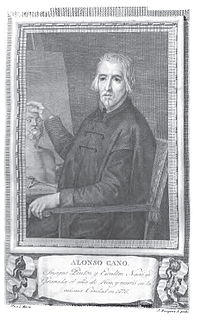
Alonso Cano Almansa or Alonzo Cano was a Spanish painter, architect, and sculptor born in Granada.

Juan de Valdés Leal was a Spanish painter and etcher of the Baroque era.

Spanish art has been an important contributor to Western art and Spain has produced many famous and influential artists including Velázquez, Goya and Picasso. Spanish art was particularly influenced by France and Italy during the Baroque and Neoclassical periods, but Spanish art has often had very distinctive characteristics, partly explained by the Moorish heritage in Spain, and through the political and cultural climate in Spain during the Counter-Reformation and the subsequent eclipse of Spanish power under the Bourbon dynasty.

Saints Justa and Rufina (Ruffina) are venerated as martyrs. They are said to have been martyred at Hispalis (Seville) during the 3rd century.

Jerónimo Jacinto de Espinosa (1600-1667) was a Spanish Baroque painter. His father was the painter Jerónimo Rodriguez de Espinosa, who had relocated to that area and gotten married there in 1596. He was the third child, of six. His family returned to Valencia in 1612.
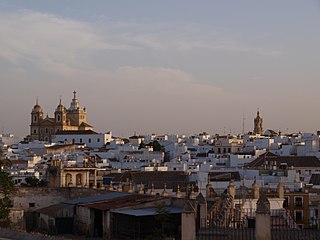
Marchena is a town in the Province of Seville in Andalusia, Spain. From ancient times to the present, Marchena has come under the rule of various powers. Marchena is a service center for its surrounding agricultural lands of olive orchards and fields of cereal crops. It is also a center for the processing of olives and other primary products. Marchena is a town of historic and cultural heritage. Attractions include the Church of San Juan Bautista within the Moorish town walls and the Arco de la Rosa. The town is associated with the folkloric tradition of Flamenco. It is the birthplace of artists including Pepe Marchena and Melchor de Marchena, guitarist.

Juan de Roelas, de las Roelas or Ruela was a Flemish painter whose entire documented career took place in Spain. He played a major role in the transition from Mannerist to Baroque painting in Spain.

Mary has been one of the major subjects of Western Art for centuries. There is an enormous quantity of Marian art in the Catholic Church, covering both devotional subjects such as the Virgin and Child and a range of narrative subjects from the Life of the Virgin, often arranged in cycles. Most medieval painters, and from the Reformation to about 1800 most from Catholic countries, have produced works, including old masters such as Michelangelo and Botticelli.
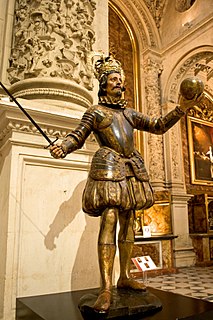
Pedro Roldán (1624–1699) was a Baroque sculptor from Seville, Andalusia, Spain. His daughter Luisa Roldán, known as La Roldana, was also a major figure of Spanish Baroque sculpture.

Saint Apollonia is a 1636 oil-on-canvas painted by the Spanish artist Francisco de Zurbarán. It is currently held and exhibited at the Louvre in Paris.
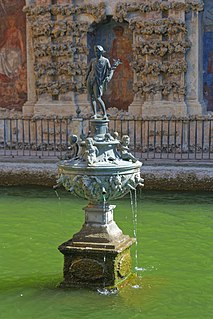
Diego de Pesquera was a 16th-century Spanish sculptor of the Sevillian and Granadan schools. Records show he was active in the city of Granada in 1563, and in Seville from 1571 to 1580. With a style influenced by the Italian Renaissance and that of Michelangelo, he may have trained in Italy.

The Birth of the Virgin is a 1661 painting by the Spanish artist Bartolomé Esteban Murillo.

The Immaculate Conception of El Escorial is a circa 1660–1665 oil religious painting by the Spanish Baroque artist Bartolomé Esteban Murillo, now in the Museo del Prado in Madrid. Murillo's many artistic depictions of the immaculate conception of the Virgin Mary were enormously influential on later art. This painting is regarded as one of his best. It was earlier identified as the Immaculate Conception of the Granja due to a mistaken understanding of its history.
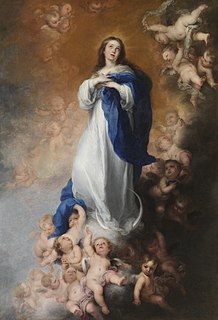
The Immaculate Conception of Los Venerables or The Immaculate Conception of Soult is an oil painting by the Spanish artist Bartolomé Esteban Murillo. It was painted c. 1678 and measures 274 cm × 190 cm. Looted by Marshal Jean-de-Dieu Soult in 1813 and taken to France, it was bought by the Louvre in 1852. It has been held by the Museo del Prado, Madrid, since 1941.

The Vision of Saint Anthony of Padua is a 1656 oil on canvas painting by Bartolomé Esteban Murillo, commissioned by the chapter of Seville Cathedral as the altarpiece for its chapel of Saint Anthony of Padua, where it still hangs. It replaced an altarpiece by Bernardo Simón de Pineda.

The Immaculate Conception of San Vincente is a c.1640-1645 oil on canvas painting by Bartolomé Esteban Murillo, now in the parish church of San Vicente Mártir in Seville.